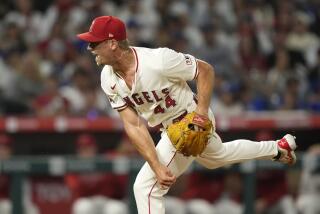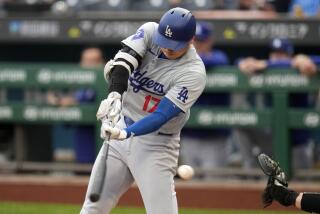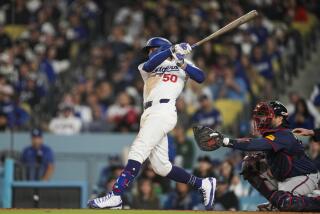The Speed Kings of Baseball: Feller Has the Edge on Ryan and Koufax
- Share via
Every time the smoke of another of those showcase gems by Nolan Ryan, the baffling Old Man of fastball pitchers, reaches Cleveland, Bob Feller feels a twinge. Perhaps it can be interpreted as a twinge of jealousy; it’s a definite twinge.
Ryan and Sandy Koufax are Johnny-come-latelies. Walter Johnson’s blaze of glory was in the dim age before mass communications. Feller was the Strikeout King of the early days when radio and then television told us about the romance of the fastball.
Great hitters move their hands when they talk about the fastball the way fighter pilots describe the climb of an airplane.
“Feller was the best pitcher I ever saw,” said Ralph Kiner, who flew a fighter, hit against Feller and broadcast Ryan. “He threw as hard as Ryan and had a better curve.”
Feller accepts compliments as comfortably as he accepts paid autograph sessions. He won 266 games from 1936 to 1956 and missed almost all of four seasons during World War II. He won 25 the year before he left and 26 the full year he returned, so he might have won another 80 or 100 games. By the time he was Ryan’s age, 42, Feller had been retired four seasons.
Feller pitched three no-hitters and 12 one-hitters. Ryan has five no-hitters and 11 one-hitters.
“Ryan has us on longevity,” Feller said. “My wife says his arm must have been built on a Wednesday. I still say Johnson must have been the fastest.”
It was Feller’s generous tip of the cap to Johnson. Feller still owns the record for the fastest fastball in the semi-official clockings listed by the Hall of Fame. Ryan’s best is 100.8 mph. Feller’s was 107.9. He’ll stand up to defend that mark.
The strikeout records are subject to interpretation. When Ryan struck out 383 in 1973, it was during the era of the designated hitter and he didn’t get to throw to a single pitcher. But when Feller struck out 348 in 1946, a strikeout was still a strikeout.
Velocity is an absolute. At 90 mph, a bit faster than the 87 mph of the average big-league fastball, the hitter has 0.42 seconds to get his bat on the ball. At 107.9 mph, the hitter has 0.35 seconds.
Good hitters can handle the best fastball, if there is no other pitch to go with it, but the fastball is still the ultimate weapon. Consider that great fastball pitchers are tiny increments ahead of one another, and that the great Koufax was never timed faster than 93.2; the notion that Feller threw more than 7 mph faster than Ryan is dazzling.
That the gap between Ryan and any pitcher could be 7 mph invites some skepticism. Johnson and Smokey Joe Wood were measured against a speeding motorcycle; when do you start the clock and when do you stop it is the great variable.
Feller was timed in 1946 on photo-electric devices the Army’s Aberdeen Proving Grounds used to test weapons. Feller was known as Rapid Robert and Bullet Bob at the time. “It was as fair as the radar guns they use on Ryan and the others today,” Feller said.
Calvin Griffith,’the penurious owner of the Washington Senators, advertised for a week that Feller would undergo a speed test before the game on Sunday. “He never told me,” Feller recalled. He was getting stretched to warm up when Griffith informed him the equipment was ready.
“I was being paid by the numbers of games I won and attendance at home, not by Griffith,” Feller said. He refused.
“If I won a game, I got $2,500,” Feller recalled. “I told Griffith: ‘You’ve been good for baseball and haven’t made much money from it. You’re going to make $25,000 from this. I’ll do it for $700.”’
Griffith brought the check and Feller went to face the timing machine, which he recalls as a triangle about three feet on a side, mounted over the plate.
From the mound, he said, he was timed at 98.6, which some lists include as Feller’s mark, but that was terminal velocity, not the average speed of Ryan’s mark. “I went right in front of the plate and threw through the triangle,” Feller said. “It was 117.2 mph.” That was muzzle velocity.
“Add them and divide by 2 and you get 107.9,” he said. “Then I went to 30 feet, 3 inches and was timed at 107-plus.
“Then I went out and pitched 13 innings to win, 2-1.”
Walter Johnson’s 97 mph of 1914 was guesstimated against the motorcycle. Feller took one of those tests too, in 1940. “I gained 13 feet in 60 feet, 6 inches against a motorcycle going 86,” Feller said. “That figures to 104 mph.”
He said Johnson must have been faster beaause of all the strikeouts he got in the time when hitters struck out very little, and the fact that Johnson didn’t have a curveball. It is the curve or some other pitch that makes the really good fastball devastating. Ryan has a good curveball; Feller had a great one.
“It would start off back here, behind your head, and it would break over the corner, low and outside,” recalls Bob Lemon, who was in the Cleveland rotation with Feller.
Movement of the ball is the distinction between being fast and having a good fastball. The best fastballs are risers, usually at the chest and climbing out of the strike zone. Rarely can a pitcher make a fastball at the knees rise.
Carl Yastrzemski, with the tying run on third base in the 1978 playoff game against the New York Yankees, looked for a fastball down from Goose Gossage and got one. “It just exploded,” Yastrzemski said. He popped it up for the final out. Gossage’s clocking is 99.4.
Kiner keeps in his pocket a list of the great fastballs. J.R. Richard was timed at 100 mph and Rob Dibble of the Cincinnati Reds recently became the only other man to reach 100. Kiner thinks Dwight Gooden, whom the Mets have at 98 mph, has lost some of the movement on his fastball.
He recalls that Rex Barney was the fastest he ever saw, but Barney couldn’t get it over the plate and there is no listed clocking of his fastball. There is none, either, for Steve Dalkowski, whose fastball is a wisp of smoke in minor-league memory. Legend says he may have been fastest of all. We’ll never know.
Feller didn’t have the average of strikeouts per game Ryan and Gooden have because the game has changed. “Then there would be guys who said you weren’t going to strike them out,” Feller said. “There’s no moral victory to it anymore. DiMaggio choked the bat two inches when I had two strikes on him.”
Joe DiMaggio hit 361 home runs and struck out only 369 times. “Today they don’t give a damn if they strike out 150 times in a season,” Feller said.
There is no clocking for Sudden Sam McDowell, who was heir to Feller’s crown in Cleveland.
In the closing stages of the career that he later admitted he drank away, McDowell was on the Yankees when Ryan missed no-hitting them by inches. “Tell them,” McDowell pleaded, “I used to throw like that.”
More to Read
Go beyond the scoreboard
Get the latest on L.A.'s teams in the daily Sports Report newsletter.
You may occasionally receive promotional content from the Los Angeles Times.










